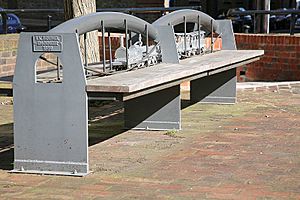Brunel Museum facts for kids
The Brunel Museum is a cool museum in Rotherhithe, London Borough of Southwark. It's located in the Brunel Engine House, which was built by Sir Marc Isambard Brunel. This building was part of the amazing Thames Tunnel, the very first underwater tunnel ever built! It opened in 1843. Sir Marc's son, Isambard Kingdom Brunel, started working on the tunnel with his dad in 1823. He became the main engineer for the project in 1827 when he was just 20 years old.
Contents
The Amazing Thames Tunnel Museum
The Brunel Museum is all about the incredible Thames Tunnel and the brilliant engineers who built it. It helps visitors understand how this groundbreaking tunnel was made and what it was like when it was used by people.
The Tunnel's Big Hole: The Shaft
The museum site includes the Tunnel Shaft. This was the world's first "caisson," which is like a giant, watertight box used for building underwater. Imagine a huge brick tower, 50 feet wide and 42 feet tall, built above ground. Then, it was slowly sunk into the earth by its own weight! Miners worked inside a special iron shield, invented by Marc Isambard Brunel, to dig the tunnel safely.
The Brunel Engine House: Powering the Tunnel
The Engine House was designed by Sir Marc Isambard Brunel. Its main job was to hold powerful steam pumps. These pumps were super important because they kept water out of the tunnel while it was being built between 1825 and 1843. It was originally a boiler house, where the steam for the pumps was made.
Since 1961, this historic building has been a museum. It shows how the Thames Tunnel was built and shares information about other projects by Marc and Isambard Kingdom Brunel. Inside, you can see a model of the tunnelling shield. There are also pictures and items from when the tunnel was used by people walking between Rotherhithe and Wapping.
The Engine House and its chimney are very important buildings. They have been officially protected since 1974. A charity helped restore the building in 1979. In 2006, the museum changed its name from Brunel Engine House to Brunel Museum. It added new displays, like a mural on the shaft showing the tunnel shield. It also features models of famous Brunel bridges built into benches.
In 2018, the museum bought a special collection of drawings of the Thames Tunnel. These drawings were made or supervised by Marc Isambard Brunel himself.
Fun Events at the Museum
The Brunel Museum takes part in the Open House Weekend every year. This event lets people explore interesting buildings that are usually closed to the public. Before 2007, visitors could even take guided tours through the tunnel on London Underground trains!
The museum also hosts many other events throughout the year. They have special activities during school holidays. You can also join walks and tours, both in person and online.
Museum Upgrades and Improvements
The museum had big construction work done in 2007. A large steam engine was moved to make more space for exhibits. They also added a cafe and better toilets. In 2011, a concrete floor was built at the bottom of the shaft. This sealed off the shaft from the train tunnels below. Now, people can sometimes go down into this amazing space on special tours.
In 2012, the roof of the shaft was turned into a beautiful Roof Garden. Since then, a cocktail bar called The Midnight Apothecary has been running there. It serves drinks made with plants from the garden.
The shaft was greatly improved in 2016 with a new staircase. This made it much easier for visitors to access the space. The staircase was designed carefully so it wouldn't damage the old brick walls. The shaft walls show many signs of its long history. You can see where original staircases were and soot from steam trains that used it for ventilation. Today, the shaft is a unique space for events and part of the museum's exhibits.
The Brunel Museum Reinvented Project
In 2019, the museum received money from the National Lottery Heritage Fund and other groups. This funding is helping them plan a big project to make the museum even better. If they get more funding, they will fix up the historic building and improve visitor facilities. They will also create a home for the newly bought collection of Marc Brunel's Thames Tunnel drawings. This project will allow them to offer even more events and activities for everyone to enjoy.
Images for kids
See also
 In Spanish: Museo Brunel para niños
In Spanish: Museo Brunel para niños







